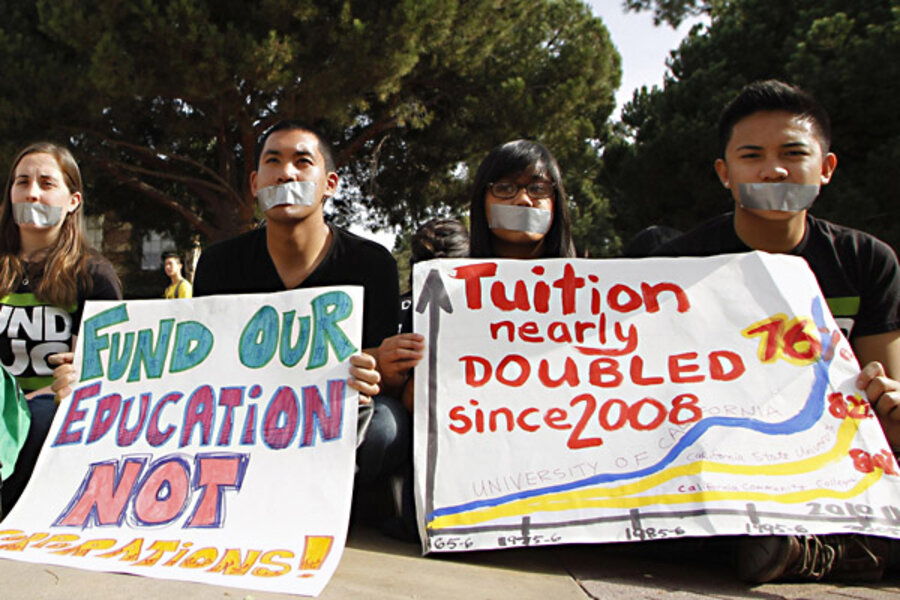How to stop starving public colleges and shrinking the middle class
Loading...
Last week Rick Santorum called the President “a snob” for wanting everyone to get a college education (in fact, Obama never actually called for universal college education but only for a year or more of training after high school).
Santorum needn’t worry. America is already making it harder for young people of modest means to attend college. Public higher education is being starved, and the middle class will shrink even more as a result.
Over just the last year forty-one states have cut spending for public higher education. That’s on top of deep cuts in 2009 and 2010. Some, such as the University of New Hampshire, have lost over 40 percent of their state funding; the University of Washington, 26 percent; Florida’s public university system, 25 percent.
Rising tuition and fees are making up the shortfall. This year, the average hike is 8.3 percent. New York’s state university system is increasing tuition 14 percent; Arizona, 17 percent; Washington state, 16 percent. Students in California’s public universities and colleges are facing an average increase of 21 percent, the highest in the nation.
The children of middle and lower-income families are hardest hit. Remember: The median wage has been dropping since 2000, adjusted for inflation.
Pell Grants for students from poor families are falling further behind; they now cover only about a third of tuition and fees. (In the 1980s, they covered about half; in the 1970s, more than 70 percent.)
Student debt is skyrocketing – the New York Federal Reserve Bank estimates it at $550 billion. Punitive laws enforce repayment, and it’s almost impossible to shed student loans in bankruptcy. There is no statue of limitations for non-repayment.
Santorum’s rant notwithstanding, good-paying jobs in America are coming to require a college degree. Globalization and rapid technological change are putting a premium on the ability to identify and solve new problems. A college degree is also a signal to prospective employers that a young person has what it takes to succeed.
That’s why the median annual pay of people with a bachelor’s degree was 70 percent higher than those with a high school diploma in 2009 (the latest Census data available).
Yet public higher education isn’t just a private investment. It’s a public good. Our young people — their capacities to think, understand, investigate, and innovate — are America’s future.
We used to understand this. During the great expansion of public higher education from the 1950s to the 1970s, tuition at public universities averaged about 4 percent of median family income (compared to around 20 percent at private universities).
Young Americans received college degrees in record numbers – creating a cohort of scientists, engineers, managers, and professionals that propelled the economy forward and dramatically expanded the middle class.
But starting in the 1980s, as in so many other areas of American life, we took a U-turn. Tuition at public universities began climbing. By 2005, it was more than 10 percent of median annual family income. Now it’s approaching 25 percent – still a good deal relative to private universities (where it’s nearly 70 percent), but high enough to discourage many qualified young people from attending.
Public higher education has been the gateway to the middle class, but that gate is shutting – just when income and wealth are more concentrated at the top than they’ve been since the 1920s, and when America needs the brainpower of its young people more than ever.
This is nuts.
What’s the answer? Partly to make public universities more efficient. Every bureaucracy I’ve ever been associated with (and I’ve been in some very big ones) has some fat to be trimmed. Yet universities are necessarily labor-intensive enterprises; research and teaching can’t be outsourced abroad or turned over to computerized machine tools.
Another part of the answer is to raise tuition and fees for students from higher-income families and use the extra money to subsidize medium and lower-income kids. Even now relatively few pay the official sticker price; many receive some discount proportional to family income. But this won’t solve the underlying problem, ether.
A big part of the answer has to be more government support for public education at all levels. This requires more tax revenues – especially from Americans who are best able to pay.
Most Americans still believe in the ideal of equal opportunity. And most harbor the patriotic notion that we have responsibilities to one another as members of the same society.
The two principles lead to an obvious conclusion: America’s richest citizens have a duty to pay more taxes so kids from middle and lower-income families have chance to make it in America.








